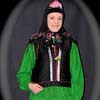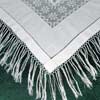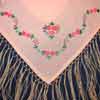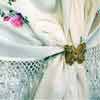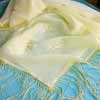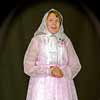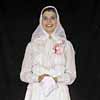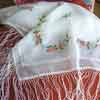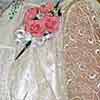Fashion Part 1 Fashion Part 2 Fashion Part 3
Women's Shawls
Doukhobor women arrived in Canada in 1899 wearing black or beige, fine woven woolen shawls. The shawls were knotted under the chin with a pleat displayed at the top. At the time, the pleat was “pressed or ironed in” by rubbing the fold against a hot chimney. These shawls were placed atop of the “kabardeenka,” a high crowned close fitting hat. (image01)
Some women wore their woolen and early rayon shawls with a pleat on each side of the face and then crossing the ends under the chin and flipping the ends over the shoulders. (image02)
The Slavic custom of wearing a shawl originated in Israel, according to Doukhobor historian, Eli Popoff. Most women, especially the elders, wore head coverings regardless of season. In winter, thick woolen shawls covered the lighter weight one. In summer, women wore head coverings made from flour sacks which they embellished with embroidery and fringes. These light weight shawls were easier to maintain as the women worked in the fields as well as the home. For the night, an elderly woman wore a “chepchik” either crocheted or sewn from a cotton fabric. (image03)
At this time, a few talented women “rasheevalee,” an art of Pulled Thread Embroidery or Openwork / Drawn Threadwork. (image 04) These shawls were exquisite – made for special occasions. This fabric art was brought from Russia, likely of Scandinavian origin. To our knowledge, this fabric art is now lost amidst our Doukhobor women and the pulled thread embroidery shawls are now heirlooms.
The art of tying a knot under the chin to secure the ends of the shawl became fashionable. Some knots were wide, some long and some techniques made the end of the shawl look like petals of a flower. (image05)
In Saskatchewan, as well as in B.C., as the communities prospered and more store bought fabrics became available to the Doukhobors, different weights of rayon fabric were purchased for making shawls. Patterns or “koimachki” for shawl borders, were developed by creative women and then hand embroidered using rayon or cotton floss. The pansy and the rose, embroidered in a continuous border, were typical of the early designs. (image06)
The fashion changed in the way the rayon shawls were fastened. The side pleats became more relaxed and pinning the ends with a simple brooch was introduced. (image07)
In the 1950s, sheer nylon fabric was introduced and the “koimachki” began to change as well. The flowers and leaves were not joined in a continuous border and a variety of flowers were selected and embroidered. Colored nylon fabric became available and the same tone of color was used for the embroidery (tone on tone). Often, this color coordination extended to the suit. The females of traditional Doukhobor wedding parties started this trend and the general female population adopted the practice. (image08)
The pinning of the shawl had become quite a skill by this time. The side pleats became less defined and the customary brooch became larger, often with crystals or colored stones. To ensure that the fringes draped evenly when the two ends were pinned, a fine basting stitch was sewn in or a crease pressed into the fabric six inches from the edge of the shawl. The fabric was folded along this line with small pleats and secured with a pin. Hat pins were used to secure the shawl from slipping off the head.(image09 image10)
As the number of skilled embroidery artisans decreased, painting floral designs on nylon shawls became popular. This fabric art, rarely practiced today, required considerable skill but much less time
(image11 image12)
About the 1950s, lace fabric became popular for sewing the traditional Doukhobor bridal suits. Usually, sheer nylon embroidered shawls completed the ensemble. For variety, some brides chose lace shawls which were then also selected by the general female Doukhobor population to complement the traditional Doukhobor suit. The purchased lace yardage was neatly hemmed and fringed. (image13)
The practice of pinning a shawl has remained a fine art. The broaches, however, have been replaced with smaller, simpler pins. (image14) Also, the selection of fabric for the traditional shawl has changed. Since the introduction of polyester sheers, this easy care fabric is the material of choice for the Doukhobor shawl. (image15).
For a less formal Doukhobor occasion, women choose to wear a triangular head covering made from a commercial lace fabric that has been machine embroidered with a scalloped edge. An alternative to the scallops is a commercial lace edging used to finish the raw edges of the fabric. Photo of triangular scarves. (image16)
Shawl fringes
The first Doukhobor hand embroidered shawls had fringes of heavy silk and later of rayon. Until the 1980s, quality fringe was available for this artistic work, however since then rayon suitable for fringes for these traditional shawls is difficult to find. Today, artisans seek the rayon fringes from Doukhobor family estates. (image17)
To Previous Page in this Section

